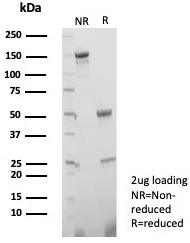Free Shipping in the U.S. for orders over $1000. Shop Now>>

SDS-PAGE Analysis of Purified TGFB3 Mouse Monoclonal Antibody (TGFB3/4801). Confirmation of Purity and Integrity of Antibody.

Formalin-fixed, paraffin-embedded human renal cell carcinoma stained with TGFB3 Mouse Monoclonal Antibody (TGFB3/4801). HIER: Tris/EDTA, pH9.0, 45min. 2°C: HRP-polymer, 30min. DAB, 5min.

Analysis of Protein Array containing more than 19,000 full-length human proteins using TGFB3 Mouse Monoclonal Antibody (TGFB3/4801). Z- and S- Score: The Z-score represents the strength of a signal that a monoclonal antibody (MAb) (in combination with a fluorescently-tagged anti-IgG secondary antibody) produces when binding to a particular protein on the HuProtTM array. Z-scores are described in units of standard deviations (SD's) above the mean value of all signals generated on that array. If targets on HuProtTM are arranged in descending order of the Z-score, the S-score is the difference (also in units of SD's) between the Z-score. S-score therefore represents the relative target specificity of a MAb to its intended target. A MAb is considered to specific to its intended target, if the MAb has an S-score of at least 2.5. For example, if a MAb binds to protein X with a Z-score of 43 and to protein Y with a Z-score of 14, then the S-score for the binding of that MAb to protein X is equal to 29.
Transforming growth factor βs (TGFβs) were originally discovered due to their ability to promote anchorage-independent growth of rat NRK fibroblasts in the presence of TGFβ. TGFβ1, TGFβ2 and TGFβ3 are each synthesized as precursor proteins that are very similar in that each is cleaved to yield a 112 amino acid polypeptide that remains associated with the latent portion of the molecules. TGFβ3 mediates many intercellular interactions that occur during embryonic development, cell differentiation and epithelial homeostasis. TGFβ3 overexpresses in extramammary Paget s disease (EPD) and downregulates in Bowen s disease, indicating that its expression is a useful indicator of tumor activity. TGFβ3 levels strongly correlate with IGF-1 and osteocalcin levels in serum. Significant amounts of TGFβ3 circulation appear to be representative of TGFβ3 expression in bone and may in part be derived from bone. Glucocorticoids may block TGFβ production by modulating mRNA levels and c-Jun activity.
There are no reviews yet.